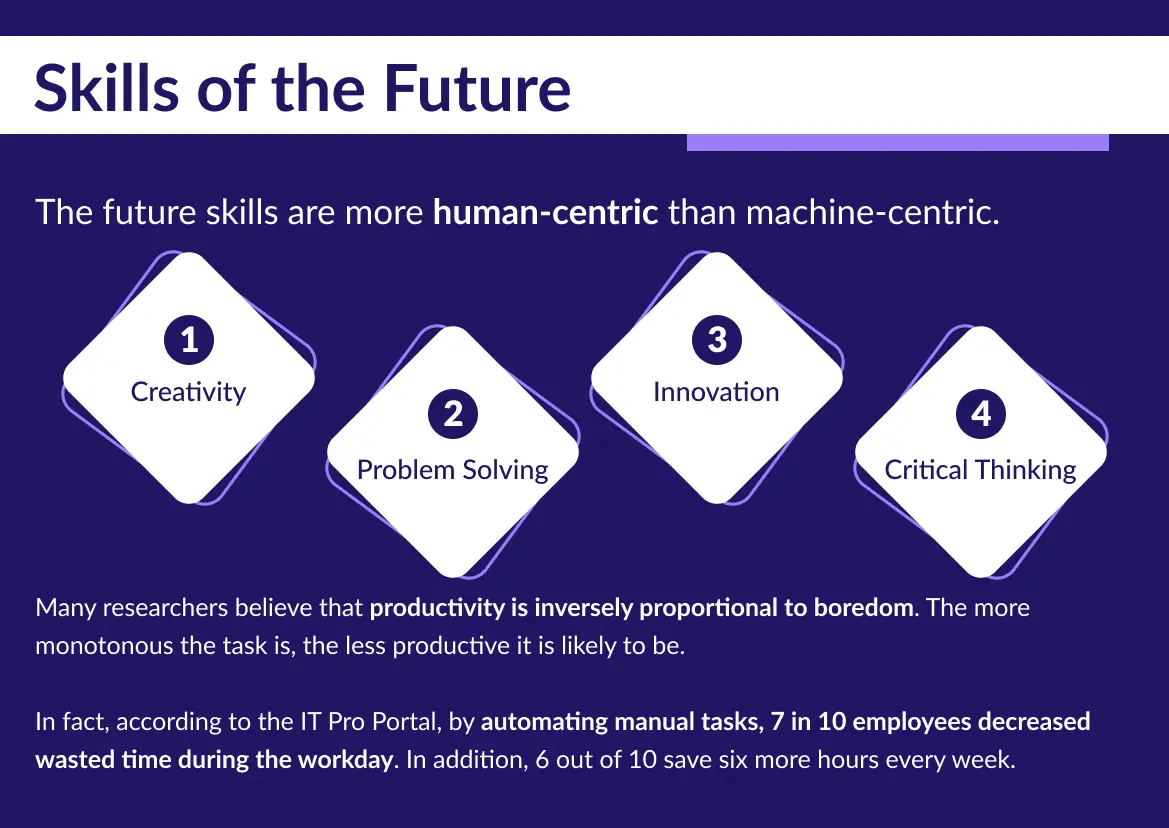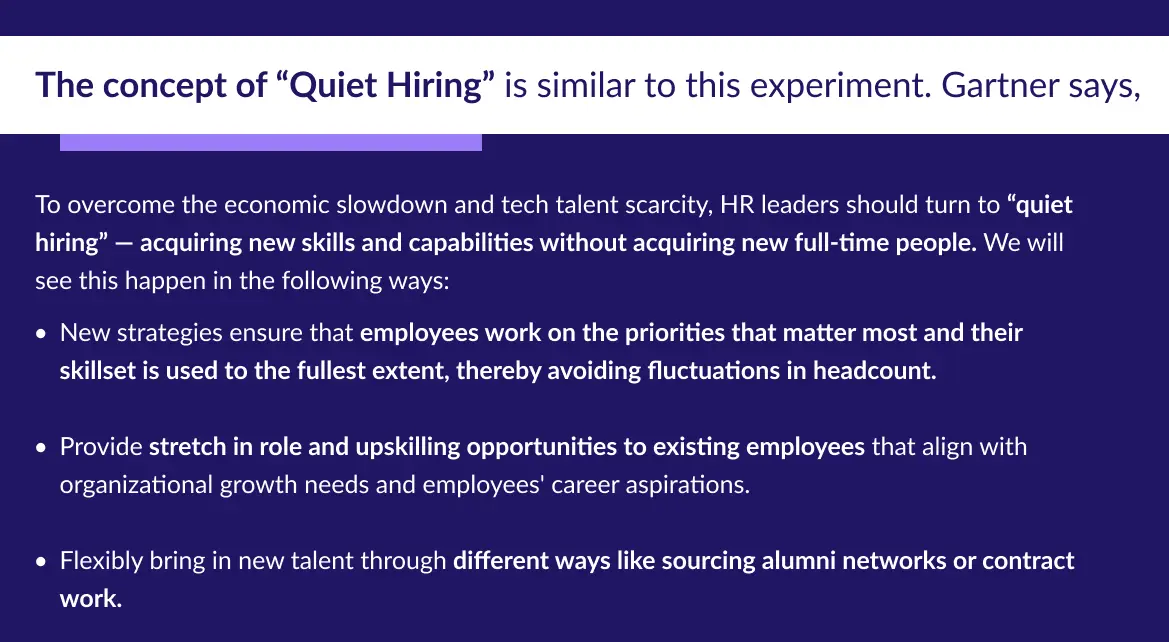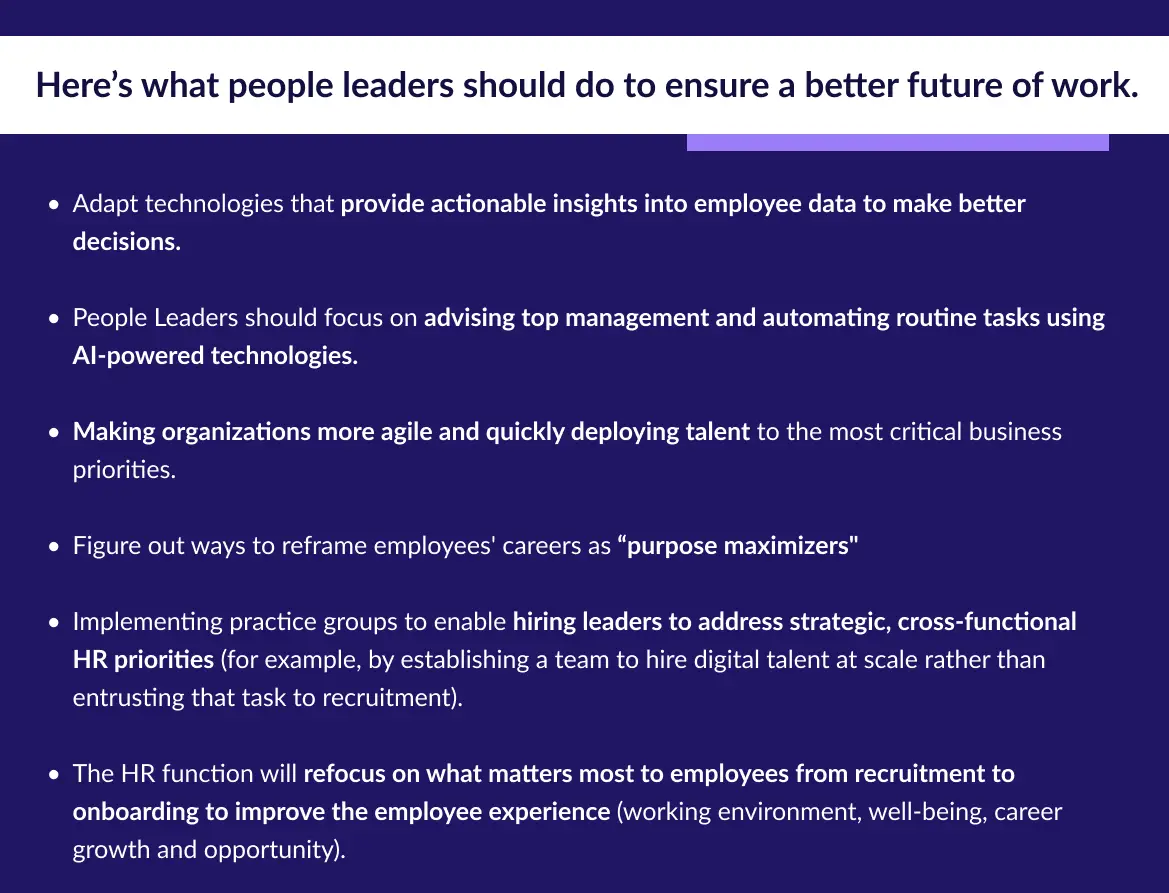Table of content
Examining how automation, AI, and the metaverse will shape the future of work. How Chief People Officers can shape tomorrow’s workplace and reframe tech careers as “purpose maximizers”
Do what you love.
We’ve all heard this phrase from many people, but in reality, most of us couldn’t find jobs that we loved doing, 365 days a year.
In 2017, innovation expert David Lee gave a TED Talk on “Why jobs of the future won’t feel like work”. In that talk, he pointed out people’s concern about moving to a jobless future and how technology will open new opportunities that people would love to work on.
He said that even in the technology-driven world, we still work with a factory mindset. We create jobs around singular repetitive tasks like cashier, loan processor, taxi driver and expect people to build their whole career around it.
Even though technological advancements like self-driven cars, machines that read X-rays, and chatbots that respond to customer-service inquiries will improve productivity and enhance our lifestyle, they will replace humans in singular repetitive tasks.
With AI and automation, the offices of the future will feel less like a job, where we have to show up daily. Instead, they will feel more like video games we’re excited to play.
Humans will get a chance to use their creative muscles, imaginative power, problem solving skills that ignite the fuel for innovation.
In this article, we take a closer look at how the future of work would look like. As talent acquisition leaders, how can you unlock this future and guide your organization towards a paradigm shift that blurs the line between work and passion?
Reasons Why Jobs of the Future Won’t Feel Like Work
Unlike the past two mass job extinctions, where it took 100 years to transition from farm to factory economy, and then another 60 years to move to service economy, this time we do not have that much time. Technology will transform the entire job market in 10-15 years.
Here are a few reasons jobs in the future won’t feel like work:
Let AI do the manual work: Automation of Repetitive Tasks
In the ever-evolving work landscape, automation of simple repetitive tasks is a transformative shift that holds tremendous potential. While it may initially spark concerns about job displacement, the true impact on humans is far more nuanced.
Imagine a cashier who spends hours mechanically scanning products and processing payments. Through automation, this repetitive task can be seamlessly handled by self-checkout systems, allowing cashiers to engage in more meaningful interactions with customers.
This empowers them to provide personalized recommendations, address specific needs, and create memorable experiences.
Similarly, customer support agents can rely on AI-powered chatbots to handle routine queries, freeing up their time to tackle complex and emotionally nuanced customer issues.
By automating these repetitive tasks, humans can elevate their roles, focusing on creativity, problem-solving, and empathetic connections that machines cannot replicate.
Ultimately, the automation of repetitive tasks enables us to redefine work. This transforms it into a realm where humans can thrive by leveraging their unique abilities and creating fulfilling experiences. These unique abilities of humans will become the skills of the future.
Get Quiet Hired at Your Job: The New Workplace Trend
David Lee in his talk mentioned a survey he did for a large bank who was trying to bring innovation into its culture.
They conducted a prototyping challenge and asked all their employees to build whatever they wanted using any or every skill they have.
The experiment was to find the weekend version of each employee. This is because everybody is creative until they have to get back on Monday to become HR Specialist or System Analyst – the same old boring jobs.
The results were shocking. Lee found that each employee has skills that can be used in other departments to ignite innovation and growth. However, these skills were suppressed because of the controlled job environment that doesn’t allow expansion.
By retaining employees and upskilling them, businesses can save money on payrolls and recruitment costs.
Hybrid Work Setting Will be the New Normal
Hybrid work settings are poised to become the next normal. A recent Accenture survey found that 83% of respondents reported that the ideal human-centric working environment would be a hybrid workplace model.
In fact, the flexible work environment ranks third behind pay and career opportunities in factors that affect job satisfaction.
Picture a scenario where individuals have the flexibility to work from their homes, eliminating stressful commutes and allowing for a healthier work-life balance.
At the same time, they can enjoy the occasional in-person interactions and collaborations in a shared workspace.
Gartner in their future of work insights found that recruiters in human-centric flexible work environments are: –
- 3.1x more likely to see low fatigue levels among employees
- 3.2x more likely to experience high stay intent
- 3.8x more likely to exhibit high performance
This hybrid approach will nurture a sense of autonomy and trust, empowering individuals to unleash their full potential. It acknowledges the unique needs and preferences of each individual, fostering a happier, more engaged workforce.
Transitioning into Career 4.0
Career 4.0 marks a paradigm shift from traditional career models.
In Career 1.0, people typically follow one path which may or may not be the same as their parents. They spend their life doing that same job, probably in the same company for decades. This approach offers stability and predictability, but limited opportunities for exploration and growth.
Career 2.0 emerged as a response to changing dynamics, with individuals seeking new challenges by switching employers to diversify their experiences and accelerate their growth. However, it still revolved around a fixed trajectory within a single industry.
In Career 3.0, people prioritize their passions and personal fulfillment, jumping into entrepreneurship or pursuing non-traditional career paths.
Unlike our grandparents and parents, in Career 4.0, today’s individuals traverse a dynamic landscape. They collaborate with diverse companies and cultures while passionately pursuing their unique talents.
For instance, many expert developers are now joining hands with platforms like Supersourcing. This allows them to diversify their portfolio by working on different projects for different companies. This keeps the work challenging and exciting at the same time. It also allows them to work on their passion. It’s a multitasking generation who wants to do everything they ever wanted to do in this life.
Enter the Metaverse – Where Work becomes Play
Working in the metaverse will be the next big step in remote work normalization. Teams will meet in their organization’s customized virtual office spaces to meet, socialize, and brainstorm via their personal avatars.
A gamified experience will blur the lines between in-person meetings and remote collaborations in the metaverse.
Imagine a world where your office is a vibrant playground, where creativity flows effortlessly, and collaboration transcends geographical constraints. It’s like stepping into a virtual wonderland, where passion and purpose intertwine, creating an immersive and fulfilling work environment.
With limitless possibilities in the metaverse, if you work remotely, it might not feel like work at all.
Chief People Officers’ Role in Reshaping the Future of Work
HR is no longer a support function. It is now becoming a strategic partner to the business, relevant to each department. However, fulfilling that role would require a transformation of HR itself.
Out of all of these, the area where HR has an opportunity to continue to step up is people analytics.
Companies have unused data on their employees’ performance, which they can use effectively to drive performance.
These insights will help organizations separate themselves from the crowd, for example, by understanding whether a given company has a problem with attrition and, if so, whether that’s in certain job families, locations, or for specific types of employees.
Times are changing, and the time to act is now.
The Future of Work is a complex beast and HR leaders have to figure out ways to connect employees’ value over time.
Jobs will not feel like work because they focus on unlocking humans’ hidden talents and passions. Leadership needs to rediscover what makes us human and create human-centered jobs that leverage those talents best.
You don’t have to wait 10-15 years for the job market to change. You can start developing those skills now and act fast. Because the future of work will be tasks AI cannot accomplish, for now.
However, CEOs around the world are concerned about finding the answer to the biggest question today. This will affect the way the future of work takes shape – How can we bring tech back in touch with humanity?



